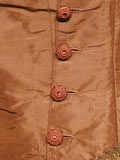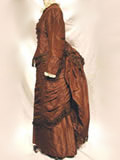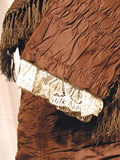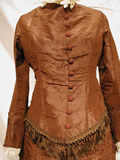The silk dress consists of a bodice, an overskirt, and an underskirt. The bodice buttons down the center front. The neckline and sleeves are trimmed with lace. The bottom edge of the bodice is trimmed with silk fringe. There is a decorative ruched "cuff' on the sleeves with a small bit of fringe at the back seam which echoes the fringe on the overskirt. The underskirt is flat across the front, has large pleats over the hips, and is cartridge pleated in the center back. The skirt's side panels gore slightly and the bulk of the skirt is toward the back and tied in place with stay tapes. There is a pocket in this skirt. There would most likely have been a small bustle pad worn under this skirt.
The overskirt creates the bustle silhouette. Like the underskirt, the front panels are relatively flat but the back panels are deeply pleated and tied inside this skirt to create a bustle pouf. It is trimmed around the hem with fringe. Because there is a pocket in the underskirt and where it is placed, this dress was probably worn as a day dress, using only the bodice and under skirt, and as an evening dress by adding the overskirt.
Bodice
The neckline is corded and decorated with a hand box-pleated lace stitched 1/2" down from the cording on it's facing. The lace is 36" long and 2 1/2" wide. There are two seams in the cording: one 1/4" in front of the right shoulder seam, the other 1 1/4" from the left shoulder seam. All the stitching is by hand.
There are 10 buttons center front, originally placed 1/2" from the center front line. The original facing has been let out 13/4" at the top, 2" at the fifth button, and 1 1/2" at the hem. The buttons are spaced 13/4" apart and begin 2" down from the neck edge. There are four hooks and eyes starting under the third button down, and placed half way between each button. Buttonholes are hand worked 3/16" away from the center front edge, which has been top-stitched by machine.
The bodice has two darts on each side which show evidence of being let out 1/2" total on each dart. The darts closest to center front were shortened 3/4" at the top, the second darts were lowered 1 1/2". The darts are machine sewn and the raw edges are hand overcast. Alterations include a dart taken around the waist from the second dart to 2" past the side seam. The original side seams had been let out 1 1/2" to 13/4" down the length of the seam.
The tight side back flat lining is pieced and slip stitched together. Both original side back seams remain unaltered. The center back seam has been let out 1/4". There is a twill tape tab at the waist line between side back seams measuring 4" long. The deeply box pleated tail at the center back shows signs of a minor, and possibly the last, alteration done to this garment. The folds of the pleats were sewn loosely together with a burgundy thread, creating a silhouette more like an hourglass. The left side seam shows two previous alterations of the bodice.
| Figure 1: Inside back of bodice. |
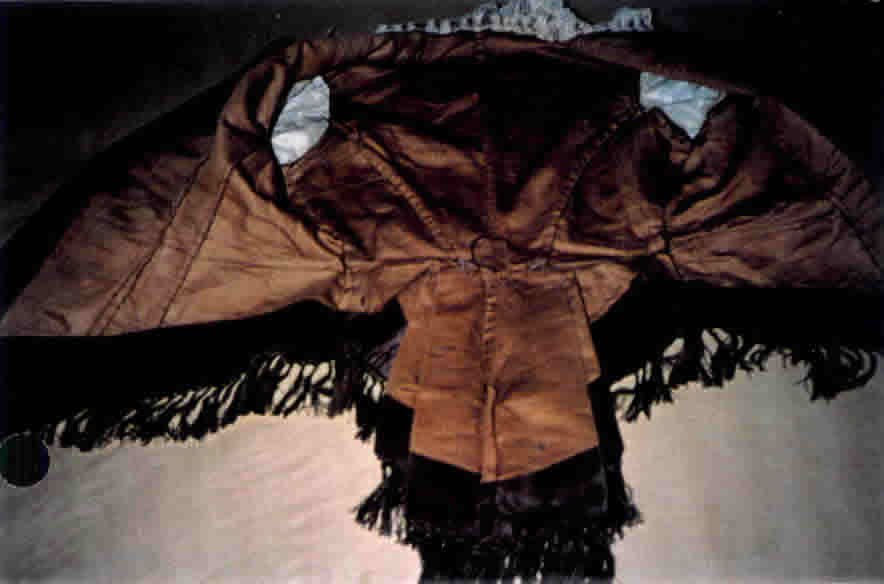 |
Sleeves
The sleeves are flat lined with a cream-colored glazed cotton fabric. The sleeve seams are sewn by machine from the shoulder seam, under the arm and around to where the second dart is. The cap is set in by hand using a small running stitch and the 1/4" seam allowance is hand overcast. The sleeve seam is stitched by machine and the edges overcast. The armscye is corded except at the extreme underarm, which appears to have been let out. There is a 2" facing around the hem. The same hand box-pleated lace is used at the sleeve hem and the neck edge. It measures 24" before pleating.
The sleeves fit perfectly into the armholes and the seams show no signs of alteration, except for the gap in the cording. The different flat lining in the sleeve seams seems to indicate that the sleeves had been completely re-made when the dress was let out. It is also possible that the sleeve lining was intentionally contrasting, like the linings in men's wear.
Sleeves are trimmed with self fabric cuffs which are 5 1/2" finished length, and are shirred by hand in five rows. There is fringe trim on the back seam of this cuff detail. The seam of the cuff lines up with the back seam of the sleeve.
Overskirt and Underskirt
The overskirt is bustled and consists of six panels. The back three are deeply pleated to accommodate a bustle. The front three panels have seven rows of vertical shirring. Fringe trims the entire hem. It has a side back closure. The skirt has machine seams but the hem and trim are both done by hand.
The overskirt has an original waistband of glazed cotton. The front panels are shirred to 1" strips of the same fabric. Shining is done in rows of three, spaced 1/2" apart. At 11" down from the waistband, there is a 10" twill tape from true side seam to the other, creating a bustle pouf. The hem is piped with the skirt fabric.
The fabric used for this dress was only 17 1/2" wide. Most of the skirt panels are rectangles of this width. Other panels make thrifty use of this narrow cloth. The entire underskirt consists of nine panels.
There is an 11 3/4" band of glazed cotton inside the skirt hem, stitched 11" up from the bottom. The raw edge is scalloped. A woven braid wraps around the very edge of the hem~ protecting it from wear.
The two center back panels are cartridge pleated to a more recent extension on the waist band. Moving around towards the front of the skirt, the third and fourth panels each have 1 1/2" deep knife pleats. These two panels are also tapered at the waist.
On the right side front, there is a pocket 8 1/2" down from the waistband. It has a 6 3/4" opening, is stitched by hand, and is faced in both sides with the skirt fabric.
The original waistband was 26" long. The extended waistband measures 33". The original was 1 1/2" tall, and was the flat lining fabric on a fold. The addition of a burgundy ribbon makes the waistband 3 3/8" tall. The changes in the waistband appear consistent with the changes in the bodice. There are two braid loops in the inside sides of the band, each measuring 4 1/2" long.
| Figure 2: Inside back of overskirt: the tape holds the side seams together, forcing the center back panels into a bustle shape. | Figure 3: Glazed cotton serves as a stay for the multiple rows of shirring. |
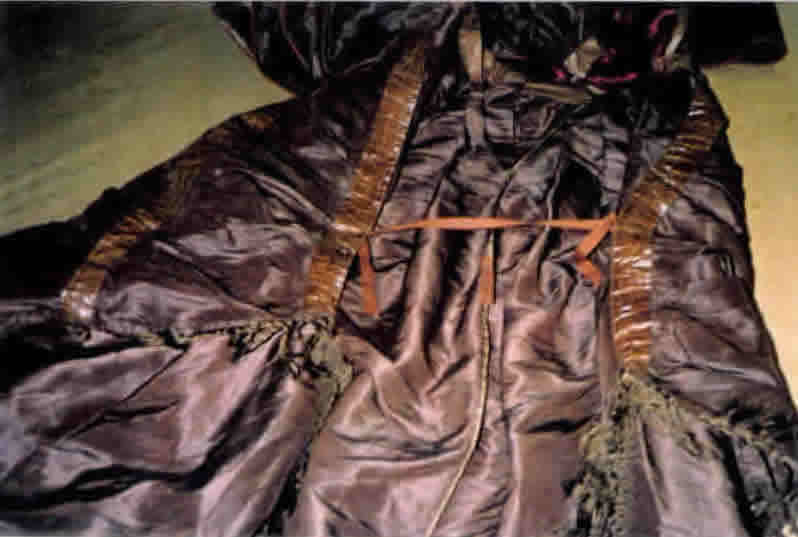 |
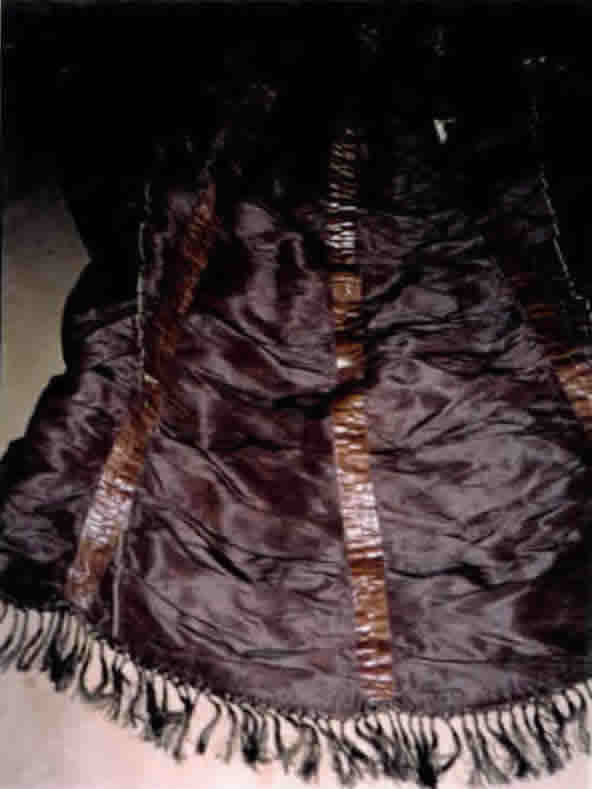 |
© Lisa Davis, 1998


